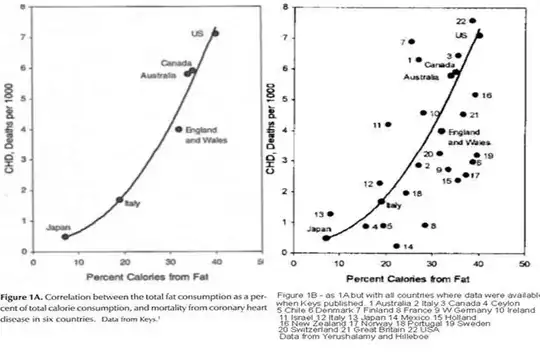The question above is a little confused mixing claims about Ancel Keys' 7 countries study which he organised, and his 6 (22) countries study. These studies are commonly confused.
The 6 (22) countries study was one he authored himself and presented in 1953 at a symposium at Mt. Sinai Hospital, New York City. Some of the work came from field work done in Europe 1951-1952 when he was a Senior Fullbright Fellow headquartered at Magdalen College, Oxford, and other data came from research grants from the National Heart Institute, and the National Dairy Council, Chicago.
In the paper he describes his methods and he discusses the validity of death certification. He excludes
Western Germany, and Finland because of major population shifts and
other effects from the war, and Iceland, Luxembourg and some colonies,
and semi-independent states with very small populations.
In the paper, he clearly states that
So far it has been possible to get fully comparable dietary and vital
statistics data from 6 countries.
Now if you look at his graph together with Uffe Ravnskov's right hand graph where the claim of cherry picking is made. Ravnskov includes data for all 22 countries for mortality data and consumption of total fat ( not saturated fat as is stated in the question ) which was collected by Yurushalamy & Hilleboe ( using different sources from Keys ).

You now have a chance to see the data for the countries he dropped. Mexico's (14) data was notoriously unreliable, and appears to go against the trend. But note that Finland (7) is also dropped where the relationship appears to be even stronger (the numbering seems wrong for the countries). So, this is very odd cherry picking that removes data that both supports and weakens the hypothesis. And it is clear that the relationship still is present even if you include the data which was considered by Keys to be unreliable or not comparable, or where the diets were not considered different enough to include.
The 7 countries study was a totally different beast. This was a multicenter prospective long term study which started in 1957:
Beginning in 1957 Keys and his colleagues began what would eventually
be known as the Seven Countries Study by surveying 12 000 men aged 40
to 59 from 18 areas of seven countries (Italy, the Greek Islands,
Yugoslavia, the Netherlands, Finland, Japan, and the United States).
Study communities were chosen for their contrasting dietary patterns
and the relative uniformity of their rural laboring populations.
Through central chemical analysis of the foods consumed by randomly
selected families as well as diet-recall measures, Keys and his
colleagues were able to determine that in societies where fat was a
major component of every meal (i.e., the US and Finland), both the
blood cholesterol levels and the heart-attack death rates were
highest. Conversely, in cultures where diets were based on fresh fruit
and vegetables, bread, pasta, and plenty of olive oil (i.e., the
Mediterranean region) blood cholesterol was low and heart attacks were
rare. The report published in 1970 had a decisive impact on CVD
prevention, as it described one of the first studies to clearly show
that dietary saturated fat leads to CVD, and that the relationship is
mediated by serum cholesterol. [3]
Regarding Taubes' purported claim, that Keys picked the 7 countries for the 7 countries study knowing that their data would support his suspicions, then this is already addressed in his paper. The entry criteria included:
Study communities were chosen for their contrasting dietary patterns
and the relative uniformity of their rural laboring populations.
It would be logical to assume that further entry criteria were that they shared similar diagnostic criteria, and the countries were stable enough to support such a long term study.
It is absurd for Taubes to write that Keys 7 countries study was invalid as he was somehow able to predict the results 29 years in advance, and that each population would show the same relationship of diet with heart disease both between countries and also inside each study population. (Keys published in 1986 on this study [4])
References:
[1] Keys, A. Atherosclerosis: a problem in newer public health. J Mt Sinai Hosp N Y. 1953 Jul-Aug;20(2):118-39.
[2] Ravnskov, U. The Cholesterol Myths: Exposing the Fallacy that Saturated Fat and Cholesterol Cause Heart Disease
[3] Andrade J et al. Ancel Keys and the lipid hypothesis: From early breakthroughs to current management of dyslipidemia. BCMJ, Vol. 51, No. 2, March 2009, page(s) 66-72
[4] Keys A, Menotti A, Karvonen MJ, Aravanis C, Blackburn H, Buzina R, Djordjevic BS, Dontas AS, Fidanza F, Keys MH, et al. The diet and 15-year death rate in the seven countries study. Am J Epidemiol. 1986 Dec;124(6):903-15. PubMed PMID: 3776973
